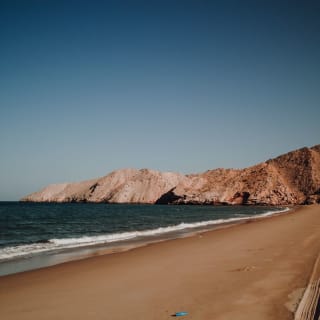
Sea Turtles
Sea Turtles
Sea turtles have always been part of the natural fauna of the region and have an ancient symbiotic relationship with the coastal lands of Oman. Today, however, these marine mammals are acutely endangered and are protected worldwide. The Omani government is involved in the preservation of the prehistoric reptiles and for this reason, has set up several nature reserves along the country’s coasts. For the sea turtles, the approximately 2000 kilometer coast of the country plays an invaluable role, since it serves the animals as a place for their propagation and where they can lay their eggs. It is the most important breeding ground for sea turtles in the Indian Ocean. Of the only seven species of sea turtles living in the world today, five of them nest on the beaches of Oman, giving Oman what you might call a world record in the area of sea turtles.
Normally, these turtles live almost exclusively in the water. Only for oviposition do female sea turtles swim ashore. Usually, they reach an age of around one hundred years and become sexually mature at the age of forty. Their main food sources include shells, seaweed, jellyfish and algae.
The Ridley Sea Turtle (Lepidochelys Olivacea) also has its breeding ground on the coast of Oman. Unfortunately, experts do not predict a good future for these animals and expect their extinction in the next few years.
Pleasantly different is the case of the Green Sea Turtle (Chelonia mydas). Their preferred breeding area is located on the stretch of coast between Ras al-Hadd and Rays Rasar. A little further south in the region, around the Island of Masirah, we find the largest population of the Loggerhead Turtle (Caretta), and on the Ad Daymaniyat Islands, there is a reserve for the Cabbage Turtle (Eretmochelys imbricata). A fifth species, the Leatherback Turtle (Dermochelys Coriaeca), has its habitat in the waters of Oman but does not breed there. The Leatherback Turtle is best known for its size. With a length of more than two meters and a weight of up to 900 kilograms, it is a colossus among its peers and in fact the largest living turtle in the world.
In Oman, despite the extremely strict protective measures, tourists have an opportunity to experience observing aquatic turtles in the wild. Ras al Jinz Turtle Reserve is the best-known place for this, not least thanks to its excellent tourist infrastructure. In the hot summer months, the nocturnal animals come onto land by the thousands and in fact outnumber the humans. In the winter months, however, it is usually the other way around and there are many curious tourists but few visible turtles.
The best time to observe the actual hatching of aquatic turtles is in October, as it is usually less crowded on the beaches. In order to ensure the protection of the turtles, a visitor pass must be obtained, which is available directly at the entrance to the respective beaches. Since turtles are extremely sensitive to and frightened by light, flash photography is strictly prohibited when taking photos. Visitors are therefore expected to behave in a calm and peaceful manner and maintain a sufficient distance from the animals.
Even at a distance, the sight of these unique animals is an impressive spectacle. With their peculiar slowness, the animals, which can weigh up to 140 kilograms, search for a suitable place for oviposition. Once the nesting site has been found, digging the nest can take them up to an hour before the animals drop as many as 120 golf-ball-sized eggs and then return to the open sea. In most cases, a female will create three such nests in a single breeding season and repeat this procedure only every two to four years. However, turtles do not have to worry about incubating their offspring. This is done by the sun, which heats the sand to the required temperature and helps incubate the young.
After almost two months, the next generation hatches and instinctively instantly heads for the sea. After hatching, many baby turtles, unfortunately, fall prey to birds, numerous other natural hunters and other dangers lurking in the sea. Only a few of the young animals survive to sexual maturity and return only decades later to their place of birth in order to complete the reproductive cycle.
Discover Oman with experts who have called it their home
Your dream holiday, tailor-made by experts.
We don't just know Oman from books, we visit the country several times a year to experience the culture, landscape and people first-hand.
From your first enquiry to your return home, we are there for you personally - by phone, email or WhatsApp, whenever you need us. Our trips are as unique as you are: individually planned and provided with exclusive privileges and high-quality arrangements that will make your trip unforgettable.
Experts for your Oman trip







